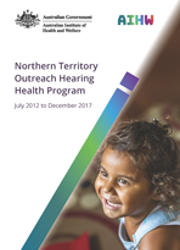Summary
This report presents updated information on ear and hearing health outreach services for Aboriginal and Torres Strait Islander children and young people aged under 21 in the Northern Territory, between July 2012 and December 2017. These services were funded by the Australian Government and delivered by the Northern Territory Government.
Service delivery targets have been met, but numbers fell in 2017
- In 2017, 1,870 outreach audiology services were provided to 1,707 children and young people—over 500 fewer services than in 2016.
- 876 ear, nose and throat (ENT) teleotology services were provided to 815 children and young people—almost 300 fewer services than in 2016.
- Clinical Nurse Specialists (CNSs) conducted 876 visits to 830 children—almost 300 fewer services than in 2016.
- A total of 1,879 children and young people received at least 1 audiology, CNS or ENT teleotology service in 2017. This was a decrease of almost 400 children from 2016.
The drop in numbers in 2017 is largely due to a shortage of available specialists to provide services in remote communities.
Hearing health is improving among children and young people who received hearing health outreach services
The percentage of children and young people with at least 1 ear disease decreased by 5 percentage points, from 66% to 61%, between July 2012 and December 2017.
The percentage of children and young people with hearing loss decreased by 10 percentage points, from 55% to 45%, between July 2012 and December 2017.
Children aged 0–5 who received audiology services were more likely to have improvements in hearing impairment and hearing loss over time, compared with older children. This is consistent with other studies that demonstrated that early intervention is effective in improving hearing health outcomes for children.
Among children who received at least 2 services between 2012 and 2017 and who had hearing loss at their first service, 55% had improved—a change from bilateral to unilateral hearing loss or from unilateral hearing loss to no hearing loss .
Among children who had hearing impairment at their first service, 65% had improved—moving to a lower degree of hearing impairment or to no hearing impairment.
Over 3,000 children and young people are still waiting for hearing health services
While a number of hearing health services have been provided to Indigenous children and young people in the Northern Territory, there are still high numbers of outstanding referrals. As at December 2017, there were 3,010 children and young people on the waiting list for outreach audiology services and 1,681 on the waiting list for ENT teleotology services.
Progress against benchmarks
All targets for 2017 have been met or are on track to be met (Table 1).
Table 1: Progress against benchmarks, 2017
| 2017 Target | Outcome in 2017 |
|---|---|
| At least 1,700 audiology services per year | 1,870 audiology services provided |
| At least 700 CNS services provided per year | 830 CNS services provided |
| 60 preventative hearing health promotion or 131 preventative hearing health promotion or training services/activities in 2017 | 131 preventative hearing health promotion or training services/activities in 2017 training services and activities provided |
Note: targets were met in 2017.
| 2017 Target | Outcome in 2017 |
|---|---|
| Less than 10% of children tested with moderate/ 2.5% of children tested with moderate/severe severe conductive hearing impairment | 2.5% of children tested with moderate/severe severe conductive hearing impairment conductive hearing impairment, July 2015–Dec 2017 |
Note: Target is on track to be met at the end of 2018.
| 2017 Target | Outcome in 2017 |
|---|---|
| Less than 14% of children (0–5) 11% of children (0–5) with CSOM, with CSOM | 11% of children (0–5) with CSOM, with CSOM July 2015–Dec 2017 |
| Less than 11% of children (6–15) 9.6% of children (6–15) with CSOM, with CSOM | 9.6% of children (6–15) with CSOM, with CSOM July 2015–Dec 2017 |
| Less than 8% of children (0–5) with 7.5% of children (0–5) with dry perforation, dry perforation | 7.5% of children (0–5) with dry perforation, dry perforation July 2015–Dec 2017 |
| Less than 17% of children (6–15) with 14.2% of children (6–15) with dry perforation, dry perforation | 14.2% of children (6–15) with dry perforation, dry perforation July 2015–Dec 2017 |
Note: Target is on track to be met at the end of 2018.
Preliminary matter: Abbreviations; Symbols
1. Introduction
Why is ear and hearing health important?
Ear and hearing health in the Northern Territory
2. Service delivery
Health education, promotion and prevention
Outreach audiology
ENT teleotology services
Clinical Nurse Specialist services
3. Ear conditions and hearing health status
Ear conditions
Hearing status
4. Demand for ear and hearing health services and other follow-up services
Follow-up services required after audiologist visits
Follow-up services required after ENT teleotology services
5. Outcomes of children after exiting the program
Time spent in Hearing Health Programs
Changes over time in hearing health
Further actions and recommendations
6. Regional analysis
Hearing loss
Hearing impairment
Ear conditions
7. Progress against benchmarks
Service delivery
Health outcomes-hearing impairment
Health outcomes-middle ear conditions
Appendixes
Appendix A: Supplementary tables
Appendix B: About the Hearing Health Program data collections
Appendix C: Data quality statement
End matter: Glossary; References; List of figures; List of tables



